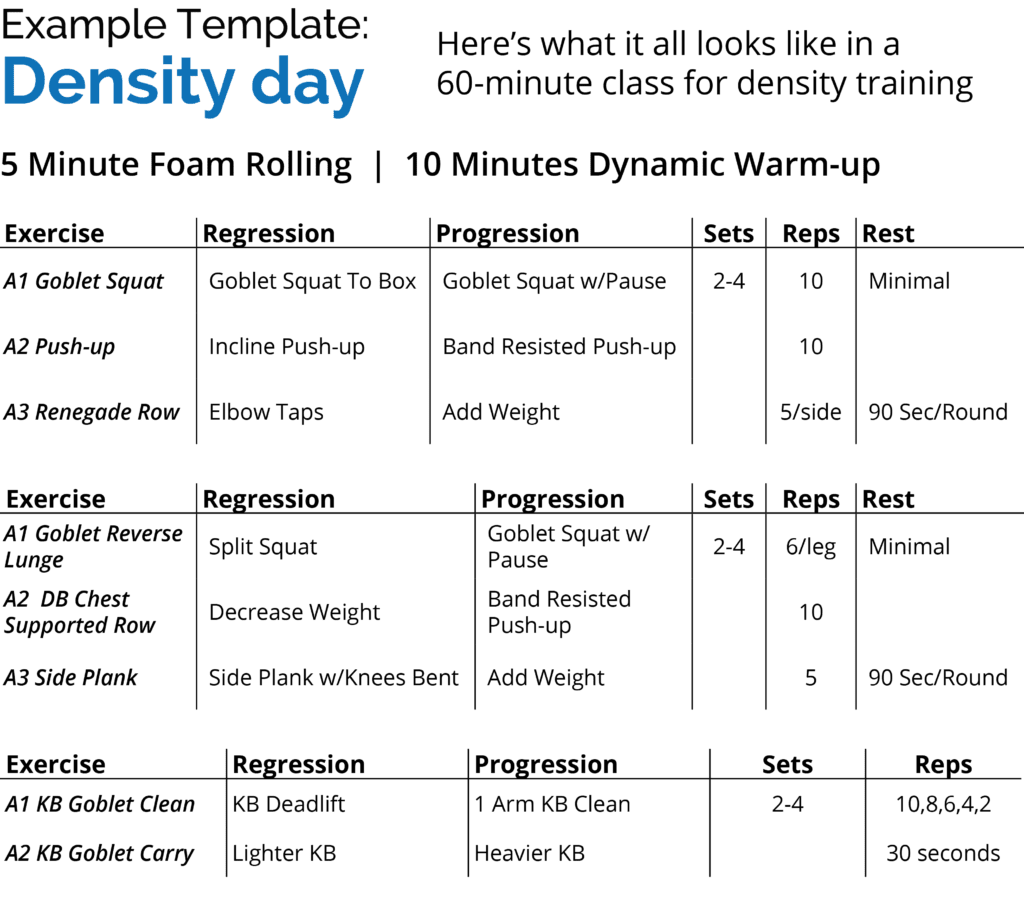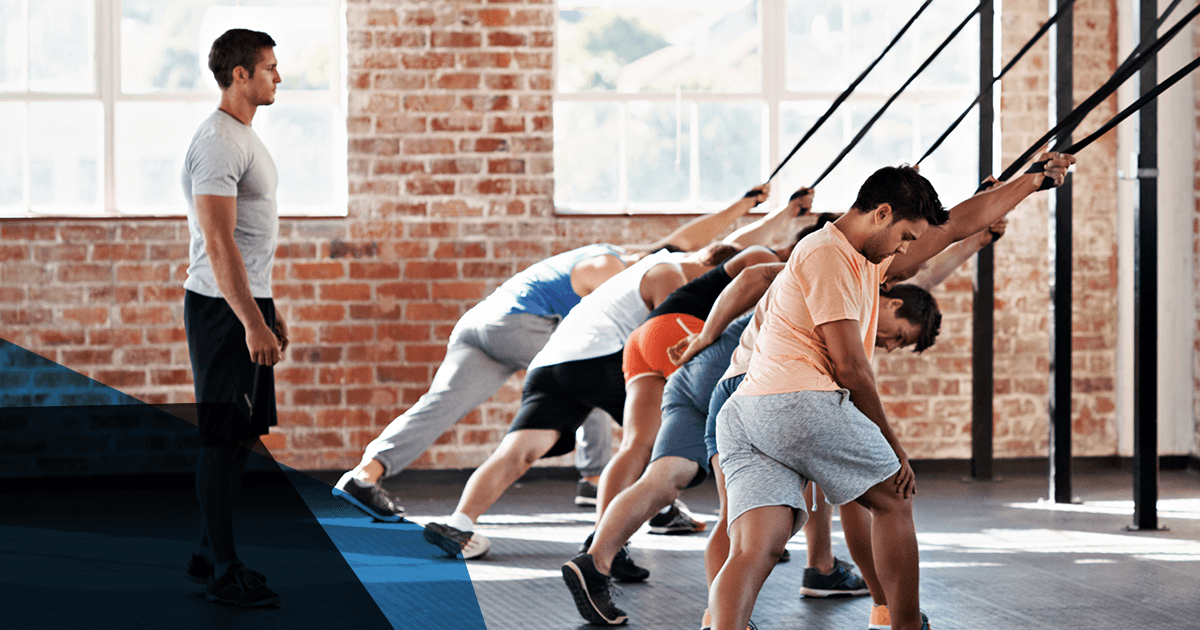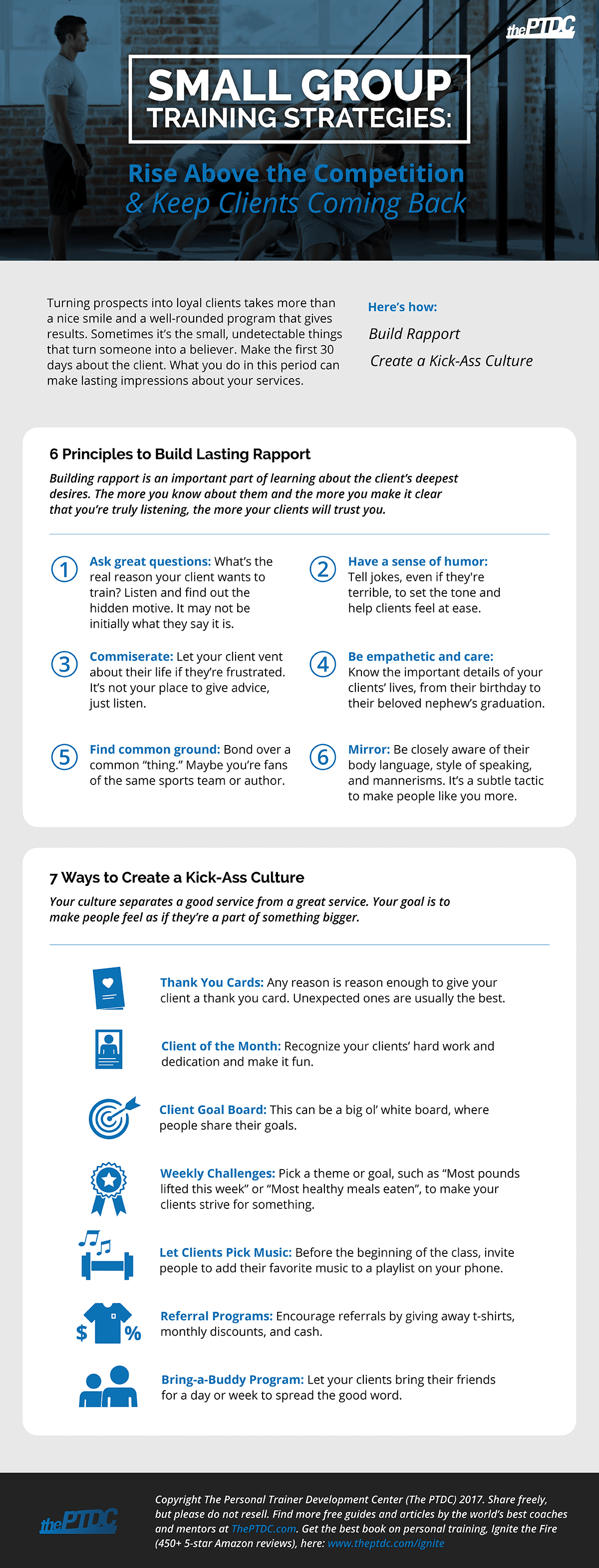Everyone told you that small group training would be more profitable and efficient, but they also left out a lot of crucial details for your success. They never addressed questions like:
- How do you get new clients?
- How do you set yourself apart from the thousands of other small group coaching, CrossFit gyms, and boot camp-style classes?
- How do you accommodate people with different fitness levels?
- How do you assess so many people at once?
- What kind of equipment do you need?
During my three years at Cressey Sports Performance, I had the chance to coach over 350 small and large group training sessions. You better believe that I learned a lot about building, maintaining, and growing a successful small group training program.
In this article I’ll guide you with lessons that I wish someone else had told me when I first started. You’ll learn:
- The two simplest steps that savvy trainers do to win over clients.
- The best programming strategies for running small groups no matter the size.
- The GOLD STANDARDS for amazing programming.
- How to train different skill levels within the same group.
- What outstanding, successful coaches do to stand out and get clients coming back.
Let’s get to it.
(Click image to enlarge.)
Create Fans of Your Program in Two Steps
Competition is fierce. It is no longer enough to just get people in the door. They won’t magically become your clients. Your job is to win them over and inspire their trust in you. Here’s how.
Successfully owning the small group training market borrows some of the same elements from selling one-on-one training. Specifically, two elements:
- Building rapport
- Creating a culture clients love
1. Building Rapport
“If you can see John Smith through John Smith’s eyes, you can sell John Smith what John Smith buys.” - Alwyn Cosgrove of Results Fitness.
Make the first 30 days about the client. What you do in this period can make lasting impressions about your services.
To know what your client needs, ask questions and keep quiet in order to be able to listen to your client and get into their mindset during the initial assessment. By simply listening, you’re able to learn key details about your client.

This is building rapport. Jonathan Goodman, founder of the PTDC, describes six steps to building rapport in an article about taking care of personal training clients. The six steps are:
- Ask great questions. Tease out the real reason why your client wants to train with you. Listen intently and find out the hidden motive. It may not be initially what they say it is.
- Have a sense of humor. It’s just nice to make someone smile and make the training session fun. Tell jokes, even if they’re terrible.
- Commiserate. Clients come from all walks of life, but all of our struggles are similar but may take different shapes. Offer your ear to your client’s problems. If they don’t already open up with you, establish a precedent by saying something like, “Hey, Bob, it seems like something is bothering you today. I’m here for you if you need. And if we need some privacy, we can use my office, too.” Then, as Goodman suggests in his article, let the client vent. It’s not your place to give advice, just listen.
- Be empathetic and care about them. Know the important details of your clients’ lives. Keep a spreadsheet about your clients that highlight their birthdays, favorite sports teams or music, or even their nephew’s graduation date. Work these details into your interactions to show that you care and build more trust. In another article for the PTDC, Goodman produced a worksheet for you to download: (http://www.theptdc.com/2014/01/tracking-personal-training-clients/)
- Find common ground. Maybe you’re both fans of the same sports teams or author. Whatever it is, having a “thing” between you and the client makes bonding easier.
- Mirror. When they stand, you stand. When they sit, you sit. This is called mirroring, which is being conscious of their body language, style of speaking, and mannerisms. It’s a subtle tactic to make people like you more.
For a more in-depth look at how to build rapport and make clients love you, check out the article here: https://www.theptdc.com/2017/02/build-rapport-giving-client-gifts/
Another thing to do is introduce new clients to existing members. It’s the easiest way to make a new client feel welcome and get them to trust your program.
Additionally, I have learned that clients want to get to know us. While it is okay to chat about you and your life when they ask, it can take away from the experience. Whenever possible, redirect the attention back to the client.
For example, if a client asks about your music tastes, you can answer with a couple off the top of your head and follow it up with, “How about you? What kind of music would you love to work out to?” Then actually play that music the next time they’re training with you.
You’d be surprised by how simple, small details like this make people stick around longer and help your program grow.
2. Creating a Kick-Ass Culture
A culture isn’t just one big thing that you create. Culture arises from a bunch of little things and people. When I was at Cressey Sports Performance, we did whatever we could to help people feel like they were a part of something bigger. These included:
- Thank You Cards: Any reason is reason enough to give your client a thank you card. Unexpected ones are usually the best. If your client pulled a PR that day, show your client you care by getting the team to sign the card and sending it through the mail, as Goodman recommends.
- Client of the Month: Regularly recognizing your clients’ hard work and dedication is important, but make it fun by having that Client of the Month wear a silly but spectacularly awesome hat or t-shirt during workouts for a week, for example.
- Client Goal Board: Get a big ol’ white board and have people write down their goal and maybe a deadline. When clients can see one another’s goals, it can be motivating and create tons of positive energy.
- Weekly Challenges: Pick a theme or goal, such as “Most pounds lifted this week” or “Most healthy meals eaten”, to make your clients strive for something. The emphasis is on fun, so don’t make clients feel bad about not achieving it.
- Let Clients Pick Music: Before the beginning of the class, have your music player ready--perhaps an iPhone with Spotify--and invite people to add their favorite music to the playlist.
- Referral Programs: Referrals can be the lifeblood of your business. You can encourage referrals by giving away t-shirts, monthly discounts, and cash.
- Bring-a-Buddy: What better way to show off your program than to let your clients bring their friends for an entire week. We did this on a semi-annual basis at CSP Strength Camp and found great success with signing up friends of friends as new members.
There are a lot of options to pick from, but I recommend starting with just one. Usually, choosing music is easiest. See how your clients respond and gradually add more.
The Secret to On-Boarding Beginner Clients
You’ll inevitably encounter a mix of beginner and advanced fitness levels within the same group. You might think to separate them, but there’s no need to. Why?
Your experienced clients will sell your training for you.
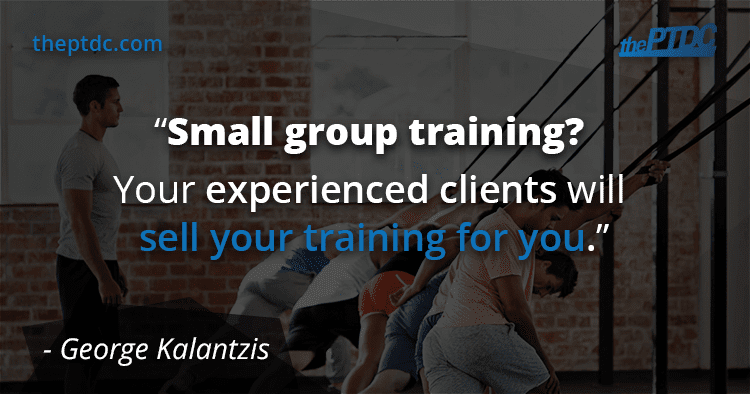
Let’s say you have a few rookies in the class, along with a few experienced clients. The newcomers are understandably hesitant, timid, and may not be sure this class is right for them. You need a way to assuage their doubt and nervousness.
So point out your superstars in the group and show, not just tell, the rookies that they can eventually, with enough time and practice, be as proficient as the advanced clients. Actively introduce the veterans to the newcomers and encourage them to look out for each other.
What you’re doing is building a powerful testimonial of your coaching ability.
The newcomer now has someone to aspire toward; and you separate yourself from other run-of-the-mill group exercise programs because you have living proof of results.
The real question is: Are each of your clients ready for the program you’re about to put them through?
5 Assessments for Training Small Groups
Whenever a new client joined our strength camps at CSP, I performed the following tests to see if they needed more individualized attention or were ready to start group training right away. Each gives you a no-frills reference point for each client’s movement capabilities.
Overhead Squat
This test can tell you a lot about your client’s functional mobility and stability in the knees, hips, ankles, shoulders, and thoracic spine.
Instructions:
- Have your client perform an overhead squat.
- Take notes on whether they can perform the movement and how they perform it.
As Tony Gentilcore explains in the video above, you’re checking to see if the client’s dysfunction in the squat, if any, is a mobility or stability issue. A few things to look for:
- Are the client’s knees caving in?
- Are the client’s heels coming off the ground?
- Are they having trouble reaching overhead?
Single-Leg Balance
This tests your client’s balance and mobility with one leg.
Instructions:
- Have your client raise one leg as high as they can while balancing on the other leg.
- See how long they can hold it.
A “good” rating generally lasts longer than 15 seconds per side, without any major shift in weight or loss of balance. You can also have your client perform walking lunges to evaluate how they move in a single-leg stance.
Shoulder Drills
This series of shoulder movements checks if there may be any alarming issues with their overhead movements, specifically in the scapulothoracic region, T-spine, and rib cage.
Instructions:
- Instruct your client to stand tall with arms down at their side and their feet together.
- Have them close their hands into a fist and place the thumbs inside the fists.
- In one movement, place the right fist overhead and down their back as fast as possible while taking their left hand up their back as far as possible.
- Do not let your client creep their hands closer together at initial placement.
Note any deviations between each side or any pain when demonstrating the movement.
As a side note, Dean Somerset showed us another quick and easy assessment to check the client’s ability to go overhead. (Read: https://www.theptdc.com/2016/12/easiest-mobility-assessment/)
Push-Up
You’d be surprised by how many people cannot perform a proper push-up. Here’s a video by the fine-looking folks at GMB Fitness of how it should look like:
A good push-up demonstrates core stabilization and gives you an idea of trunk stability on the sagittal plane. The body should be lifted as a unit, and there should be no "lag" in the lumbar spine when performing a push-up.
Active Straight Leg Raise
The active straight leg raise checks how well your client can “separate” movement in their lower body in an unloaded position, while maintaining a stable pelvis and active extension of the opposite leg.
Instructions:
- To start, have the client lie on their back with arms out to the side and palms facing the sky.
- Keeping their legs and feet together, with toes pointing straight up and the legs pressed against ground.
- Raise one leg as high as they can without the other one moving.
- Repeat both sides.
See if they can get around 70 degrees of motion without forcing it, and make a note if there is a discrepancy from side to side.
2 Things to Note on Small Group Coaching Programs and Exercises
Two important guidelines for creating a small group training program are:
-
- Quality
- Technique
In other words, education and quality movement must be the core aspects of your training program. The goal should be to progress your clients over time and develop their confidence and movement proficiency, even if they’re at different fitness levels.
Always consider movement deficiencies and anything else that might prevent your clients from progressing in a group setting. For clients who are new to training (one year or less), stick to the basics, such as squat, hinge, single-leg movements, push, pull, core, and carries. Explain that it is important to master those exercises before moving on. (Again, you can point to the top performers of your class.)
And don’t forget these other “hidden” variables:
- Frequency: I recommend a program with at least three training days. This would allow for optimal results and prevent boredom.
- Coaches-to-client ratio: Limit the number of clients you have in each class in order to program effectively while delivering a quality experience. Typically, a small group includes two to six clients. Anything larger than that may take away from the clients’ training experience. If you have to work with more clients in a class, it’d be worth hiring another coach to assist.
- Population: Athletes need a different structure than stay-at-home moms. The baby boomer generation requires different demands than kids. Be sure you understand what your population needs from your program.
- Time and equipment availability: Will your classes go for 30, 45, or 60 minutes? What equipment do you have access to? Plan for these types of limitations in your program. More on training methods below.
Don’t overcomplicate exercise selection: if you cannot perform the exercise or explain its purpose, don’t include it in your program. The assessments you made prior (and you did do movement assessments...right?), in addition to training history, injury history, schedule, and goals, should inform the type of exercises to include.
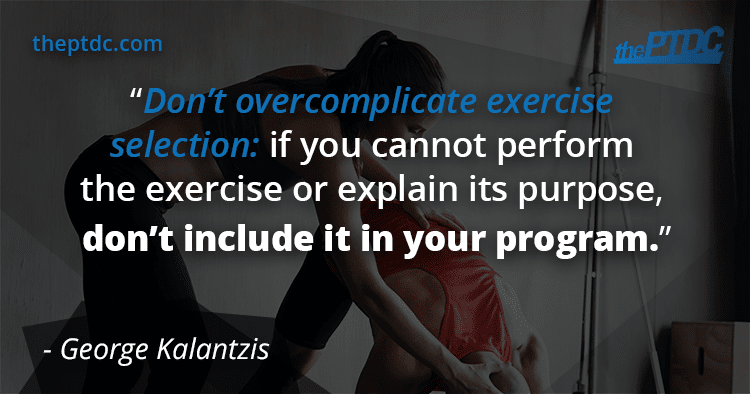
3 Effective Small Group Training Methods
There are many ways you can program for small group training, but I have found that a combination of density days, metabolic conditioning (MetCon), and strength-focused days allows optimal results and retention with clients.
Here’s a brief rundown of these methods:
Density Days
- Pros: Fairly easy to organize and coach. It offers a great combination of strength and conditioning to optimize results.
- Cons: Tough to teach newer movements due to time constraints.
In density training, you choose “stations” and assign them to a specific rep scheme and tempo for a specified length of time. Since it is a group setting, I recommend that you stick with the number of sets (minimum to maximum) that would allow your clients to get more work done in less time.
Setting It Up:
- Choose 2-5 exercises, each with 3-4 rounds. Any more and you risk injury and decreased work capacity. Any less and you do not elicit a training effect.
- When choosing rest times, select anywhere between 10-30 seconds after each exercise.
The goal is for your clients to increase their work capacity over time. You might even find it beneficial to let clients go at their own pace, which can also help them develop confidence and results.
**At the end of this article, I’ve provided you with a template for a density training day that you can use with your group.
Metabolic Conditioning
MetCon is the traditional boot camp-style type of class with a quick work-to-rest ratio.
- Pros: Very easy to coach and organize because it forces people to keep moving.
- Cons: Coaching large groups can be tough due to time constraints. It limits strength and you cannot use difficult movements.
Setting It Up:
- Choose bang-for-your-buck exercises like goblet squats, push-ups, and so on. (More exercise ideas in the next section.)
- Choose any work-to-rest ratio (e.g. 45 seconds on 15 seconds off; 30 seconds on, 30 seconds off; 20 seconds on, 10 seconds off; etc.).
Keep in mind that the more difficult the exercise, the less actual “work” you want your clients to do. Otherwise, you risk injury and compromise movement quality. Using longer intervals at the start of the workout and moving to shorter intervals as the rounds progress optimize training and reduce chances for injuries.
Strength-Focused Days
Strength days maximize clients’ strength and gives them a sense of progression.
- Pros: You can teach newer and more technical movements on this day due to the nature of programming.
- Cons: Tough to coach larger groups, as it will be difficult to pay attention to more compound lifts.
They follow a typical four-week cycle during which you assign sets, reps, and exercises that stay constant for four weeks.
How to Progress Exercises in a Group Setting
When your class mixes new with experienced clients, you need to be able to adjust for multiple levels of fitness. Remember this:
K.I.S.S.
It stands for “keep it stupid simple” -- for you and your clients.
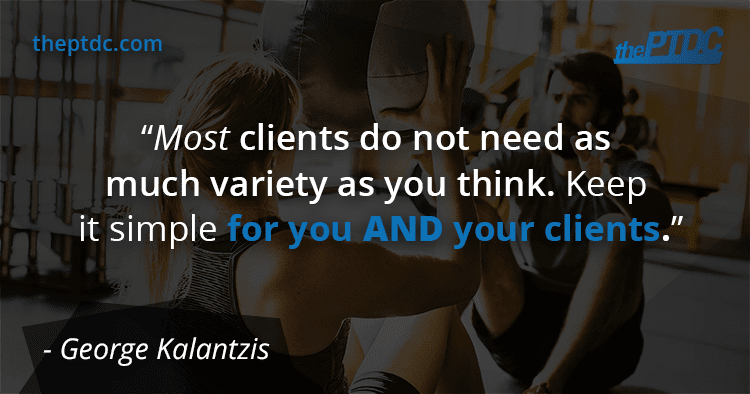
Progressing someone does not always mean you have to change exercises.
Instead, you should have at least two progressions and regressions for each exercise ready to individualize when needed. This will also make your clients feel like you care and keep them coming back for more. Use this question to guide you:
Do your clients really get bored with the basics, or do you get bored?
Most people do not need as much variety as you think. Below I provide you with a list of group-friendly beginner and advanced movements, which you can use for progressions and regressions.
Deadlifts
- Hip Hinges
Also, check out The PTDC’s article on hip-hinging here: https://www.theptdc.com/2015/07/expert-shows-exercises-for-training-the-hip-hinge/
- Pull-through
Colossus Fitness shows you how to do this exercise properly on a cable. If there’s no cable, Warrior Strength and Conditioning’s got you.
- Trap-Bar Deadlift
Mark Watts of Elitefts always droppin’ some great tips.
- Sumo Deadlift
Barbell Brigade in Los Angeles knows a thing or two about those sumo deadlifts.
- Conventional Deadlift
Coach Lee Boyce wrote a great article on coaching and cueing the deadlift that you must read. Read here: https://www.theptdc.com/2016/10/exercises-to-safely-coach-deadlifts/
Squats
While we’re at it, do you already know all about assessing your client’s current squatting abilities? If not, learn how here: How to Properly Assess a Client’s Squat
- Assisted Squat
You can use a TRX or cable to help your client counterbalance as they learn the squat.
- Bodyweight squat
Renowned bodyweight workout master Al Kavadlo lays out the details of the perfect bodyweight squat.
- Dumbbell or Kettlebell Goblet Squat
Bret Contreras doing a dumbbell goblet squat, but you can use kettlebells, too. Jazz it up with a pause, a “heartbeat”, or a faster tempo.
- Two-kettlebell or off-set squat
Or here’s an offset squat.
- Back and front squats
Read The PTDC’s guide on assessing a client’s squat here. But also, bearded hero Alan Thrall of Untamed Strength gives ideas on front squatting when your client has poor mobility.
Single Leg Exercises
Each video below gives specific examples of the types of single leg exercises.
- Counterbalance
The idea here is to offer alternatives with counterbalance (via a TRX, band, squat rack, or wall) if your client has difficulty.
- ISO Hold and Stationary
George Kalantzis (oh, that’s me!) doing a goblet split squat. What a guy.
- Dynamic
This is an example of making an exercise dynamic. Another is this reverse lunge with bicep curl.
- Bars
This is great if you have access to plenty of barbells.
Push-up
- Elevated
Your client can rest their hands on the smith machine, pins, a bench, etc. for an incline push-up.
- ISO holds
Add in a little isometric work at the bottom or top of the push-up.
- Eccentric
Go down ever. So. Slowly.
- Band-Assisted
An alternative to knee push-ups.
- Loaded
RogLaw showing a push-up with resistance band for more load and added external instability.
Pull-Up
- Lats Engagement
ATHLEAN-X sharing how to properly engage lats for better pull-ups.
- Inverted Row
Greg O’Gallagher of Kinobody demonstrating inverted rows, which are great for helping people build up to a pull-up.
- Assisted
Can’t do a pull-up? Try using a box or a resistance band.
- Eccentric
Just take it slow and steady.
Here's something you can try using at your next class for density day.
